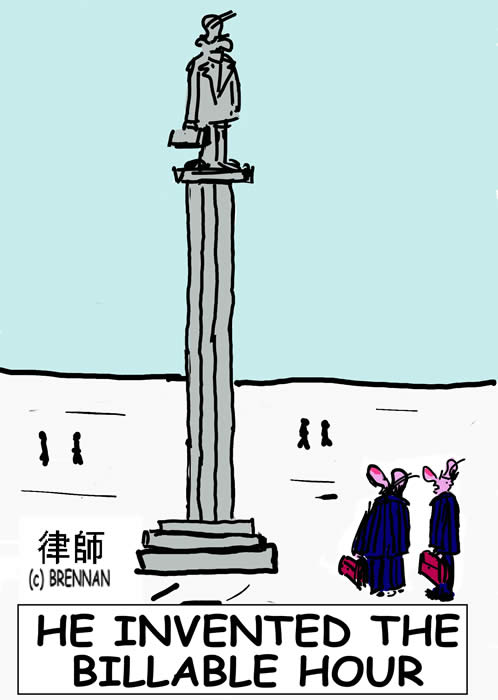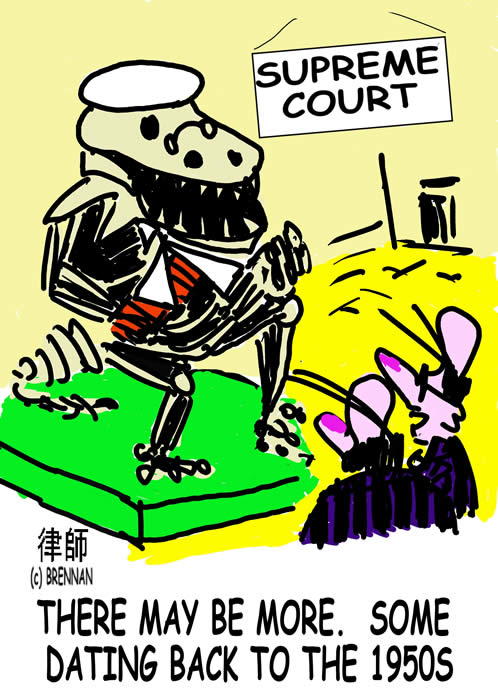
Volume
30 - MAY 2009

If you have time, join me at the breakfast launch of the new Entreprenet Network (details below). Or click here to vote for a Law & Disorder cartoon in the New Matilda Cartoon Competition.
All the best
Paul Brennan
Editor
Going broke? Plan ahead

When you go bankrupt your affairs are taken over by a trustee in bankruptcy (“T in B”), a sort of “Life Coach” with a sombre bent.
If you are ever faced with bankruptcy you will have two choices:
- honourably accept your fate; or
- try to wheedle your way out of it?
People tend to do 1. only after they have given 2. a good shot. Anyway, that is my plan.
But, the problem for “wheedlers” is that over the centuries every stunt has been tried with mixed results. Therefore, you are unlikely to come up with anything new. Worse still, the lawyers drafting bankruptcy legislation are supposed to have closed the loop holes.
Anyway, most people manage to arrive at bankruptcy with their liabilities cancelling out any assets that they still have. It is the job of the T in B to “claw back” any assets sold at an undervalue or sold or transferred to defeat creditors.
In Australia for example, there are basically 4 main claw backs of assets transferred:
1: to defeat your bankruptcy, for any duration. There is no time limit on your T in B making this claw back. The test is: should the recipient have reasonably known that the bankrupt was insolvent?
2: at an undervalue within 5.5 years. This is reduced to 4 years where a family member is involved.
3: to a “related entity” meaning family or companies controlled by them within 1 year unless the recipient can prove that the bankrupt was not insolvent.
4: to an unrelated entity within three (3) years unless the recipient can prove that the bankrupt was not insolvent.
Often, bankrupts have a very good relationship with their T in B like hostages often do with their captors. For others, it is as if your old headmaster is back in your life. Depressing, I know.
(c) Paul Brennan 2009 is a practicing Queensland lawyer and author of the “10 Greatest Legal Mistakes in Business…and how to avoid them”.
Being busy-the 8th habit
 Is your lawyer busy? As a junior lawyer, I may have struggled to draw up the correct documents, or write a letter which did not need substantial amendment but, I got the hang of being busy, straight away.
Is your lawyer busy? As a junior lawyer, I may have struggled to draw up the correct documents, or write a letter which did not need substantial amendment but, I got the hang of being busy, straight away.
There are many advantages to being busy. You can arrive late at meetings, not return telephone calls, cut short conversations or simply be MIA (Missing in Action) at Court for days on end, leaving things to your secretary. You no longer need a “to do list”. Things do not slip by, as other people are constantly calling you up and asking you where it is. You are of course too busy to take their calls but it is an option not usually available to diligent people.
But now everyone seems to be at it.
Plumbers used to arrive on time and were “under the gun” of the lady of the house until the job was done. Now, by using the “busy” business model they not only get paid more, they can arrive late but still find house owners forgiving and circumspect. Mobile phones allow plumbers to escape to other emergencies.
Doctors applying the ”busy” model have time for a chat, despite the full waiting room.
Being busy has been recognized as a spiritual tool and an essential part of the “Law of Attraction”. Apparently, you will find the universe amending the work practices of others so that they do some of your work to try to get you to the stage, you should have been at, if you had not been so busy.
In fact, developing the habit of convincing people that you are busy has been hailed as the new alternative to customer service and a lot less taxing.
(c) Paul Brennan 2009.
![]() Click here to invite Paul Brennan to speak at your next event
Click here to invite Paul Brennan to speak at your next event
“Without Prejudice” the Legal Time Out
 While Free Masons have secret handshakes, lawyers have the “without prejudice” communication (“WPC”). Sad I know.
While Free Masons have secret handshakes, lawyers have the “without prejudice” communication (“WPC”). Sad I know.
WPCs help lawyers to negotiate settlements openly without worrying that their words will sneakily be repeated in court in this dispute or another. It is a legal “time out”.
For instance, anyone can put “without prejudice” at the top of a letter and it cannot be used in court against anyone, or by anyone, or even in other court cases. Well almost.
Masons may have their critics, but at least once they establish a secret code they stick to it, unlike lawyers who need to pick at things.
But sometimes, it is not convenient for something to be secret and courts will apply common sense to admit it. This is either a refreshing change or a pain in the neck depending on which side you are on.
For instance, you failed to settle using WPCs and then an application was made by your opponent to throw your case out due to your delay. Here, by telling the court of the WPC you are not catching the other side out but simply not allowing them to take "liberties". It is to prove a fact independent of the issues in dispute.
Sound logical? Well, here are a few more: constituting an act of bankruptcy, a severance of a joint tenancy and a trigger for a rent review clause. You had to be there.
Despite, repeated assaults over the centuries, Courts have said it is public policy to allow lawyers a “breather” and applied the WPC rule generously and widely, refusing to introduce procedural or linguistic technicalities to weed out the parts that deserve protection from the parts that do not. As so often in the law, at times, it has been tough going.
(c) Paul Brennan 2009.
![]() Click here if you wish to make an appointment with a lawyer
Click here if you wish to make an appointment with a lawyer
Who owns what?
 Did Lennon and McCartney put all their creative effort into everything they did together or did one of them compose the music and the other write the words?
Did Lennon and McCartney put all their creative effort into everything they did together or did one of them compose the music and the other write the words?
Well, in the law of copyright, you hope it is one or the other as anything else seems to end up in a fight. As Yoko will tell you.
Suppose you can draw and someone else has an idea for a book. The characters are his idea but you will be creating a visual representation of those characters.
Who owns what? The problem is that your contribution is not distinct from that of the author.
The author wants to be able to promise his publisher that no one else has a right to use the drawings in the book and believes he has paid you quite enough. Whereas, you may not want him to use your drawings in other books, magazines or anywhere without further payment or at all, if you are vindictive.
They may be your drawings but as they are based on characters suggested by the author, it is probably unlikely that you have sole copyright. However, you may have joint copyright if you pass this three part test:
- There must be collaboration, a shared goal.
- You must put in sufficient creative effort but it does not need to be an equal contribution. It is the sort of creative effort that you would need to create a copyright work of your own. Not that much, but not just tracing.
- The contributions must not be distinct or separate from each other. For instance, if one person does the music and the other the words of a song these are two separate copyright works.
Of course, it would be easier to write down who owns what before you start, but what fun is that?
(c) Paul Brennan 2009 is a post graduate in copyright law and advises businesses on franchising.
Click here for more on franchising your business.
Event
Breakfast Launch 27 May 2009 of
Entreprenet - a premier business network for the Sunshine Coast. This is a Geoff Moller initiative and promises to be a great opportunity for business wanting to mix and network with entrepreneurial and innovative businesses. Paul Brennan will be speaking at the launch on ‘The 7 Greatest Legal Mistakes that Small Businesses make in a Recession ..... and how to avoid them’.
The breakfast event is not to be missed and you can register or find out more information by downloading the event flyer from www.entreprenet.com.au/entreprenet270509.pdf or by phoning Geoff on 0411 351 110. Places are limited so please register early to avoid disappointment.
| In this Issue | |
| Going broke? Plan ahead | |
| Being busy-the 8th habit | |
| “Without Prejudice” the Legal Time Out | |
| Who owns what? |
|
| Links | |
| Subscribe | |
| Unsubscribe | |
| Forward to a Colleague |
|
| Contact | |
|
Apek Publications PO Box 27 A division of Brennans solicitors and migration agents Phone: 07 5438 8199 Fax: 07 5488 8836 info@brennanlaw.com.au
|
|
